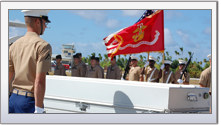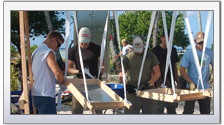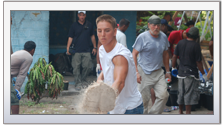 |
 |
 |
Until They Are Homeby Steven C. Barber(310) 806-5833 |
||
| The unrelenting, scorching, equatorial sun burns high in the Tarawa sky this day. I am embedded with a 17 member team from JPAC, The Joint, POW/MIA Accounting Command. This is day four of a 45 day mission, and it becomes very surreal as I think of how this is all happening because of a chance meeting with the legendary actor and bronze star recipient, Eddie Albert in 1997. | ||
He was kind enough to let me in to his home and his life, and this is where I first became aware of the battle of Tarawa. http://www.youtube.com/user/stevencbarber#p/search/0/EpZdMu8buNY Eddie was one of the unsung heroes during Nov 20-23, 1943 dragging wounded and dead Marines out of the lagoon on Red Beach under the non stop murderous gunfire of the highly trained and brutal Imperial Japanese forces that were heavily entrenched on the tiny foot hold of Tarawa. He was awarded the Bronze Star. Known as “Bloody Tarawa”, the Marines had the worst loss of life in their 200 year old history losing 1,113 men in 72 hours from Nov 20-23. It was a battle that throughout the years that had legendary status, but had not been forgotten about until recently. I had been on a mountain bike ride for an hour when I passed by 95 year old Eddie Albert who I recognized through his many films and his TV Show, Green Acres. |
||
In 2007, serendipity once again stepped into my life and I was fortunate to meet 88 year old Leon Cooper at the UCLA book fare. To this day, I know not why I was drawn to him. There were 100 people at this show, and he was the only one I spoke to. When I saw that he had written a book on WWII, I asked him if he knew about Eddie Albert and the battle of Tarawa. Not only did he know about it, but he was a 22-year-old Higgins Boat Commander and actually recounted seeing Eddie in the water at Red Beach dragging bodies out of the lagoon. So began the journey back to Tarawa in 2007. Leon and I ended up going back and producing Return to Tarawa: The Leon Cooper Story together and the film was quickly sold to the Discovery Military Channel bringing in huge ratings. |
||
Ed Harris as the narrator, gave the film a strength and an elegance that really hit home with a lot of people. A former Marine in Chicago was so upset at what he saw in the movie, that he was able to get Chicago Congressman Lipinsky to write and actually pass legislation to go look for lost Marines on Tarawa. I was contacted by JPAC two years after the release of “Return to Tarawa: The Leon Cooper Story” and was asked if I would be interested in doing a sequel. The focus would be on the amazing work of the men and women of JPAC and I jumped at the chance. My producing partner Matthew Hausle and myself headed to Honolulu for several interviews in early August 2010 and then boarded a C-17 Airlift from Hickam Air force base with a C-130 transfer in Kwajalein. The C-17 is a magnificent piece of technology. Costing approx $200 million each, the United States Air force has 200 in its fleet doing America's work around the world. Flying in the cargo hold of a C-17 for the first time is truly an exciting and adrenaline filled experience. Watching the load masters bring on C-17 palettes for the journey in quick time formation with extreme precision is a sight to behold. We were given emergency information in case of rapid decent and my cameraman/producer caught our accent as we headed yo Kwajalein with a 17 member JPAC force of strapping young men ready to look for their missing Marine brothers. When we began are decent into Kwag, I was in the back seat behind the pilot capturing the landing as we descended rapidly. It was fast, efficient and just plain fun! We were met by 3 provost guards fully armed and whisked into a rear area where we were told that pictures were not allowed. This is the Reagan Mission Testing Facility and unbeknownst to me, extremely top secret. |
||
The palettes and gear were off loaded in 40 minutes and we were once again whisked under armed guard to a waiting C-130 that had been baking in the South Pacific sun all day. The on board temperature was 110 degrees as we all grabbed our seats and strapped in for the two hour flight to Tarawa. I liken the C-130 to flying on a lawn mower at 12,000 feet. As a documentary filmmaker it was terrific for footage, but the C-17 is the aircraft of choice. Tarawa was lonely and in a foreboding hush the airport was completely empty as we landed into the setting sun. There was a complete silence, a stark contrast to what it must have been like 68 years before. It is impossible for a person to land on this forgotten and remote place in the world and not feel and know something happened here. It just has that 'feeling', impossible to describe on paper. You have to walk the ground. Day two, boots on the ground, we followed Dr. Gregory Fox and the JPAC Team to the six proposed excavations sites. Site 6 was known to be the possible ground where Congressional Medal of Honor Recipient Bonnyman may be buried. Dr. Fox was quick to point out that there was no basis for 'sight designation' as the mission called for looking for the men of the 2nd division Marine Corp. No one man would be singled out. After the 2 hour excavation tour, we all went back to our quarters to get some shut-eye. It had been a very long day. It was going to be an even longer six weeks ahead. The Marines, under the watchful eye of Capt. Nordman from Cape Giraudoux, Missouri started with an early morning run across the Nippon Highway which is the causeway that leads to Betio. There is something beautiful about watching 14 young, vibrant and lean service men in formation running toward Betio as the sun come up over the A-toll of Tarawa. After the run, pull ups ensued on a newly minted set of pull up bars placed there the day before by the Marines. After a quick and hearty breakfast at Mary’s Hotel (one of the only decent places to stay on the island) we were all off to the Coast Watchers Memorial to begin excavations. Hopes were high! |
||
In our film “Return to Tarawa: The Leon Cooper Story” we had interviewed a 6.8 ex patriot-riot who was referred to as “Big Louis.” Louis had told us that while digging a sewer line in 1978 he had found a US MARINE with the name Somes in the helmet liner. He had tried to return the remains with no success as the government had told him that all of the war dead of Tarawa had been accounted for. He decided to bury the remains 6 feet from the Coast Watchers Memorial and that was the first excavation on the docket. Dr. Fox sealed off the area with official yellow tape just like a CSI investigation and now was now officially considered a 'murder' investigation site. All the Marines on Tarawa were murdered. We know who murdered them and that is the only difference on how the site is treated. There is a reverence and a very methodical procedure, and once all the tape was up and the measurements were taken, Dr. Fox began digging within the Coast Watchers Memorial. After six hours of digging, over 100 native children and adults showed up and were behind the yellow tape eagerly awaiting (as we all were) the discovery of US Marine remains. The first dig would turn up a 1930 American penny and a small piece of ordinance. Staff Sergeant Witt, who was the ordinance specialist, deemed it to be harmless and defused, decades before. Filling the hole back up with Tarawa dirt took only 2 hours as Dr. Fox began a second hole outside the Coast Watchers perimeter and this dig would turn out very different indeed. The second hole outside the Coast Watchers Memorial was now over 4 feet deep, and just as Louis had said, a rice back and a skull began to emerge. The excitement was palpable. The 100 or so natives and the JPAC contingent were all very excited as the removal of the Tarawa dirt showed more and more of the remains Louis had buried three decades earlier. The rice bag with the remains were moved very gently and with a great degree of reverence and put into the utility vehicle that JPAC had here on Tarawa and then taken to Honolulu for identification. |
||
This was an amazing start. Very often JPAC teams will go out for weeks and never find anything, and here it is the very first week, and the recovery of an almost complete skeleton is found and these young men of JPAC are fired up. The team continues to dig meticulously for bone fragments and tons of dirt is searched through using near by screening stations that have been set up before any digging had started. The screening stations are key in the process that JPAC has in place, and prove to be invaluable mission after mission. Fort the next several weeks, the digging would continue with no days off. “The Marines were in the fight and did not get a day off,” said one young Marine, “why should we?” This sentiment is shared with all of the team members. After six weeks, spirits are high and attitudes remain very positive among the team. There had been a very special bonding that had taken place among these men that will never be broken. For the next 30 days they did nothing but dig... and dig... and dig... on five sites. Today is day 43, and all of the holes have been filled as this mission winds to a close. There has been a visit by a 3-star general from Honolulu. Col. Sullivan, the Marine Commander from JPAC had been on the ground for nearly a week. He has going out to the sites with the JPAC men and had also been involved in some functions with the government including a dinner with the vice President of Kiribati among several other special gatherings. This is where politics and good ambassador ship come into play. There are two C-17s filled with a platoon of Marines on their way to Tarawa. They will land in 24 hours and JPAC will be at the Bonriki International Airport to greet them and off load palettes. A full military honor guard for the repatriation and the found US remains will follow a one hour motorcade in route to the Marine Memorial. On Sept 20th, 2010 the Marines landed at 10:00 am sharp. Capt Nordman, the leader of this JPAC Mission was at the airport to greet 32 Marines from Camp Lejuene, Honolulu and Capt. Pendelton from Southern California. The time line was very tight, so everyone was fast tracked through customs onto a waiting bus for a tour from Molly Brown who is a wonderful local woman who gives the Tarawa Battle Tour. There were three hours to get the Marines from the airport, to Red, Green and Black beaches. The tour also stopped at one of the excavation sites where Dr. Gregory Fox gave a quick review of what happened at site number two. “The information that we received was poor,” says Fox. “The good news is we know where Marines are not!” This is an intrinsic part of the JPAC foot print as they most often have to get the information from people that may not be informed or many times have absolutely no experience in these matters. That was exactly the case for the intel on this site. Much more research from a competent and knowledgeable source will be sought out for the next mission to Tarawa. |
||
The tour moved on quickly to the Marine Memorial on Betio. Capt. Nordman and the JPAC team had been by 20 days earlier and spent 10 hours cleaning up a Memorial which had come under heavy attack from weeds and local people who like to use it for a dumping ground and outhouse. The Capt. told me that he felt it was the obligation of him and the Marines that died in Tarawa for this be a clean and pristine place. When the Marines got there, a group photo was taken and some interviews were conducted. Then it was back on the bus for the first military repatriation for Marines from the Battle of Tarawa, 68 years later! Upon arrival back to Bonriki Airport, things moved very quickly. 45 men and women changed into their dress uniforms and a full color guard was on the Tarmac in 23 minutes along with Col. Sullivan from JPAC and Maj. Orsorio from JPAC. There was a quick dress rehearsal and within four minutes, the ceremony started. Col. Shaffer from Camp Lejeune was also present. The first Marine slowly marched with his counterparts to the first set of remains and did a perfectly excuted flag draping that gave me chills - even in the 100 plus degree temepature on the steaming Tarawa tarmac. The first set of remains were covered. Then the exact same ceremonnial flag draping was performed again by a second set of four young Marines, only five feet away from the first one. http://www.youtube.com/stevencbarber#p/u/6/OMZnKeJPEQc (Filmmaker Barber playing TAPS) A Marine corp bugler sounded "Taps" as beautiful and moving as any you have ever heard before, and the coffins were placed on the C-130. Immeditlay after the color guard finished, 100 people began to move. Uniforms were changed into civilian clothes and two palettes were lifted up, and within 14 minutes the engines began to churn for the voyage home. I am on that C-130 now with 39 Marines and 6 Airforce crew. It is a tight ship, and there is a hush in the cabin over the roar of the props. Tarawa continues to fascinate all who come in contact with it and has become a legendary landscape that is considered hallowed ground for the United States Marine Corp. To walk Red Beach, Green Beach or Black Beach, the battle is still very palpable and in your face every where you go. I consider myself a very lucky soul to have been able to be part of this repatriation and this amazing story. It is my great hope to continue to tell people about the Battle of Tarawa and how bravely and courageously US Marines fought there. The battle of Tarawa represents everything that is great about America. When Americans have a vision and great resolve, there is truly nothing that can stop them... not even 4000 heavy armed Japanese Imperial Marines under unimaginable conditions! God bless the United States Marine Corp.... God bless Tarawa!! Tawara Atoll
|
